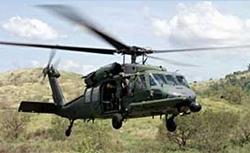Sat, Jul 05, 2003
Six Crewmembers Killed In Afghanistan
 The dark of night. A complex
refueling operation at high altitude. A pilot who may have suffered
a heart attack. All of these factors may have contributed to the
May 23 crash of a Sikorsky HH-60G "Pave Hawk" Special Operations
Helicopter in Afghanistan, according to a military report issued
Thursday.
The dark of night. A complex
refueling operation at high altitude. A pilot who may have suffered
a heart attack. All of these factors may have contributed to the
May 23 crash of a Sikorsky HH-60G "Pave Hawk" Special Operations
Helicopter in Afghanistan, according to a military report issued
Thursday.
In the Dark Of Night
The investigation, led by Brig. Gen. Gregory Power (USAF), found
that the accident occurred at 9,000 MSL in a mountainous area near
the Afghan town of Ghazni. The crew was airlifting two Afghan
children for medical care. It was just past dusk, according to the
report, when the Pave Hawk maneuvered for aerial refueling behind a
HC-130P tanker at a mere 350 ft. AGL. That's well below the 500
foot minimum required by the military.
While listing as the three primary causes the
rapid fall of night and the high altitude, the report also detailed
the autopsy performed on aircraft commander Lt. Col. John Stein.
Forensic experts concluded Stein suffered from 95 percent blockage
of his coronary artery.
"This raises the possibility that the aircraft commander may
have been undergoing angina (news - web sites) (chest pain) cardiac
arrhythmia (abnormal heart rhythm) or acute myocardial infarction
(heart attack) during the helicopter refueling or later in the
mishap sequence," the report said, as quoted by Reuters. However,
one Air Force medical witness told the investigating team that
Stein had no complaints about chest pains and had passed a physical
which included riding a stationary bicycle. The only way to find
out for sure during the flight medical would have been to
operate.
No Cause Determined
 The Air Force refused to issue a
primary determination in the accident. However, the investigation
report indicated that the Pave Hawk was trying to refuel as day
turned into night, rendering the flight crew's night vision goggles
less-than-effective.
The Air Force refused to issue a
primary determination in the accident. However, the investigation
report indicated that the Pave Hawk was trying to refuel as day
turned into night, rendering the flight crew's night vision goggles
less-than-effective.
"The terrain's high altitude ... combined with the 30-degree
bank during the refueling aircraft's climbing turn, made it
difficult to maintain the helicopter in the refueling position,"
the Air Force said in a statement. Local commanders will decide
what, if any, disciplinary action will be taken in the
incident.
More News
He Attempted To Restart The Engine Three Times. On The Third Restart Attempt, He Noticed That Flames Were Coming Out From The Right Wing Near The Fuel Cap Analysis: The pilot repor>[...]
Make Sure You NEVER Miss A New Story From Aero-News Network Do you ever feel like you never see posts from a certain person or page on Facebook or Instagram? Here’s how you c>[...]
From 2009 (YouTube Edition): Leading Air Show Performers Give Their Best Advice for Newcomers On December 6th through December 9th, the Paris Las Vegas Hotel hosted over 1,500 air >[...]
Aero Linx: NASA ASRS ASRS captures confidential reports, analyzes the resulting aviation safety data, and disseminates vital information to the aviation community. The ASRS is an i>[...]
“For our inaugural Pylon Racing Seminar in Roswell, we were thrilled to certify 60 pilots across our six closed-course pylon race classes. Not only did this year’s PRS >[...]
 NTSB Final Report: Rutan Long-EZ
NTSB Final Report: Rutan Long-EZ ANN FAQ: Turn On Post Notifications
ANN FAQ: Turn On Post Notifications Classic Aero-TV: ICAS Perspectives - Advice for New Air Show Performers
Classic Aero-TV: ICAS Perspectives - Advice for New Air Show Performers ANN's Daily Aero-Linx (06.28.25)
ANN's Daily Aero-Linx (06.28.25) Aero-News: Quote of the Day (06.28.25)
Aero-News: Quote of the Day (06.28.25)




